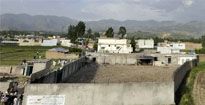CIA Spied on Bin Laden From Safe House
“You’ve got to give him credit for his tradecraft, ” said a former senior CIA official who played a leading role in the manhunt. When spotted by surveillance drones a decade earlier, bin Laden “had bodyguards, multiple SUVs and things like that. He abandoned all of that.”
The officials also outlined emerging theories as to why bin Laden apparently selected the Pakistani military garrison city of Abbottabad as the place that afforded him the greatest chance to stay alive.
The discovery of bin Laden in Abbottabad has raised suspicion that he was placed there and being protected by elements of the Pakistani military and intelligence service, but U.S. officials said they have seen no conclusive evidence that was the case.
The city, about two hours north of Islamabad by car, offered a number of advantages for the al-Qaeda leader, officials said. Chief among them is that Abbottabad, deep inside Pakistan’s borders, is a safe distance from the tribal regions that are patrolled by armed U.S. drones.
U.S. officials said they are convinced that bin Laden, who had long immersed himself among the Pashtun tribes along the border with Afghanistan, was driven from that part of the country by the escalating drone campaign.
“Even five years ago things were dropping from the sky” in Pakistan’s tribal region, a U.S. official said. “He probably felt that if he could conceal his presence [in Abbottabad] it would be an unlikely area for the United States to pursue him.”
Strikes by conventional U.S. aircraft would have carried enormous risks, both because Pakistan has invested heavily in air detection and defense systems — to counter any threat posed by India — and because of the perils of an errant strike.
“All it has to be is about 1,000 yards off and it hits the Pakistan Military Academy,” said a CIA veteran of Afghanistan and Pakistan. The city is also home to two regimental compounds, and suburbs occupied by military families.
U.S. officials said there were also disadvantages for bin Laden in residing in Abbottabad, including the fact that the area is relatively welcoming to outsiders, including Pakistanis on vacation, military families being transferred to bases there, and even U.S. soldiers who have at times been sent to Abbottabad to train Pakistani troops.
“Abbottabad is not a place where Islamic extremists went, because it wasn’t a stronghold,” said the former U.S. intelligence official involved in the bin Laden pursuit. “They preferred places like Peshawar, Quetta or Karachi.” When analysts would consider likely locations for the al-Qaeda chief, the official said, “Abbottabad wouldn’t be on that list.”
The CIA took advantage of that atmosphere to send case officers and recruited informants into Abbottabad undetected, and set up a safe house that functioned as its base.
“That is an Achilles heel for bin Laden, because anybody can go” to Abbottabad, the former CIA official said. “It makes it easier for the CIA to operate.”
U.S. officials declined to say how many case officers or informants used the facility, but they stressed that the effort required extraordinary caution because of the fear that bin Laden and those sheltering him might vanish again if spooked.
The CIA began to focus on the compound last summer after years of painstaking effort to penetrate a small network of couriers with ties to the al-Qaeda leader. Once the most important of those couriers led them to the Abbottabad compound, the conspicuous nature of the complex sent up alarms that it might have been built for bin Laden himself.
“The place was three stories high and you could watch it from a variety of angles,” the former official said. Moving into the custom-made compound, the former official said, “was his biggest mistake.”


